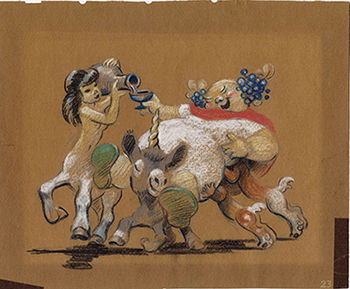
“This is not the cartoon medium…we have worlds to conquer here.” So Walt Disney described his unique masterwork from 1940, Fantasia. And so reads the inscription of text above the Fantasia case display in The Walt Disney Family Museum. The museum’s collection is comprised of more than 30,000 objects and our collections staff has been busy swapping in other items, including a recent rotation of objects in the Fantasia case in gallery 5. Here, museum guests can discover some rare gems of Fantasia production art.
A number of the new items on display are maquettes from Walt’s Character Model Department, a sort of think-tank where story ideas and character personalities were developed. One striking sculpture is that of Vulcan, Roman god of fire. A blacksmith, he forges giant thunderbolts for Zeus to hurl down towards the earth in the fourth movement of Beethoven’s “Pastoral Symphony,” a memorable sequence from Fantasia.
The maquette of Vulcan is striking, with bold accentuations of muscle making for a dramatic pose of the ancient god. This Vulcan is different from the final conception of the character that we see in Fantasia, which was animated by studio veteran, Art Babbitt. Walt and his team originally envisioned a character more classical, stylized and statuesque, with piercing eyes and a flaming beard and moustache. The final character we see in the film was not only a different color, but more “cartoony” in design.

A maquette somewhat closer to its animated counterpart in Fantasia is that of Bacchus, ancient god of wine and general merriment. Animated by Ward Kimball, Bacchus also went through multiple phases of design, but with this model we can see glimpses of the rotund figure in his rather unhinged bout of ecstasy. Jacchus, the donkey-like steed of Bacchus, appears similar to the designs of donkeys in Pinocchio (1940), save the unicorn-like horn atop its head. This statue was used by special effects artist Herman Schultheis for photographs seen in his famous “lost notebook.” And don’t miss some inspirational sketches of Bacchus by artist Jim Bodrero on view in the same display.
Other exciting pieces from the “Pastoral Symphony” include a selection of background and layout artwork. In the realm of hand-drawn animated filmmaking, literally every element of the visual presentation is created from the imagination, beginning on blank pieces of paper. The layout and background are the literal environments of the film, acting as the setting for each animator’s character to interact with and explore. Walt placed as much emphasis on each environment as he did on the characters, ensuring a wholly believable world was the product of each story he told.
Often created in the blacks and greys of pencil—like the drawing of Mount Olympus—these layouts allowed Walt and his team to decide where they would place the camera in each scene, and from there, where the camera would move. In the case of the “Pastoral,” the camera slowly pushed in towards the epic peak and valley below at the sequence’s beginning. Backgrounds were often made in watercolor, like the forest scene on display, stretching horizontally across the landscape, allowing the camera to track the action in one seamless movement.
Released over 75 years ago, Fantasia was truly a step into some new cinematic realm of possibility. The pieces described here are just a handful of the new selections to be found on display in the museum’s main galleries. Now so many decades removed from the film’s creation, each piece brings us that much closer to Walt and his team, as they boldly ventured into this new realm that to this day leaves us spellbound.


Lucas O. Seastrom is a writer, filmmaker, and contracting historian for The Walt Disney Family Museum.
Sources
-Culhane, John. Walt Disney's Fantasia. New York: H.N. Abrams, 1983. Print.
-Fantasia. Prod. Walt Disney. Perf. Deems Taylor, Leopold Stokowski. Walt Disney Studios, 1940. DVD.
